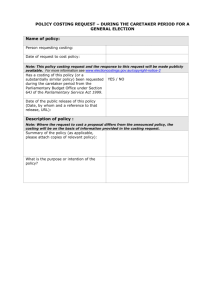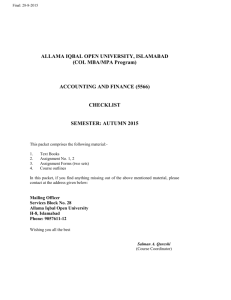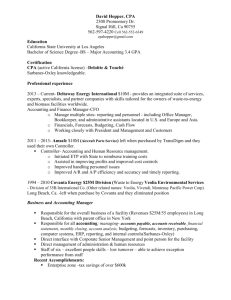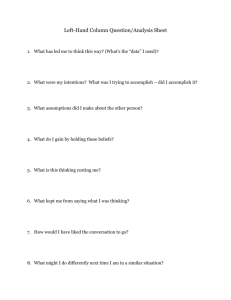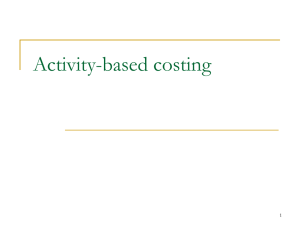Webcast Part – 1: Cost Accounting
advertisement
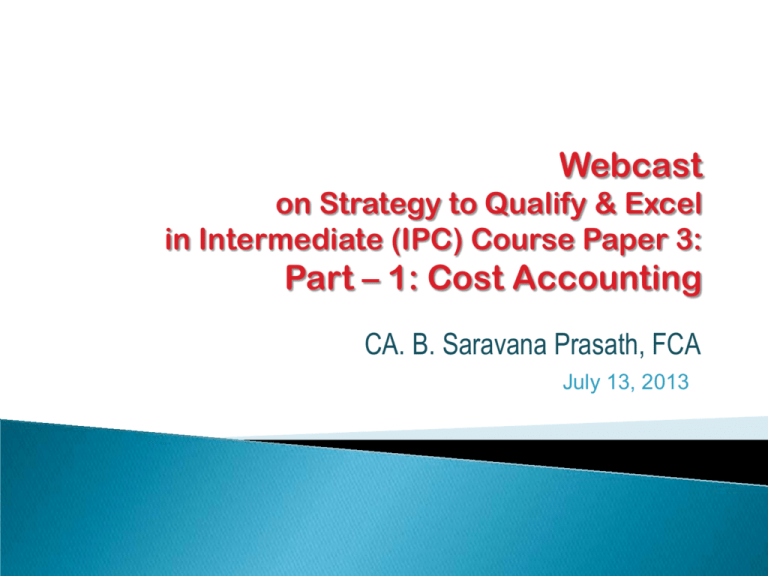
Webcast on Strategy to Qualify & Excel in Intermediate (IPC) Course Paper 3: Part – 1: Cost Accounting CA. B. Saravana Prasath, FCA July 13, 2013 Agenda 1 • Relevance 2 • Coverage & Questions Areas 3 • Exam Analysis - Questions 4 • Strategy to Qualify & Excel Chapters & Question Areas An Intro. Chapter 1: Basic Concepts Meaning of Cost, Cost A/cg Objectives & Importance Basic Cost Accounting Terms Cost Accounting vs Financial Accounting Installation of Cost Accounting System Classification of Costs Types and Methods of Costing Chapter 1: Basic Concepts - Question Areas Cost Sheet Preparation Cost Estimation for New Jobs / Orders Income Statement vs Cost Statement Use of Simultaneous Equations Basic Pricing Decisions with Cost Sheet Chapter 2: Materials Material Cost, need & importance. Purchase, Storage & Issue Aspects. Material Management Techniques EOQ, Stock Levels, ABC Analysis, etc. Methods of valuing Materials Usage. Normal and Abnormal Loss of Materials. Accounting for Waste, Scrap, Spoilage and Defectives. Chapter 2: Materials Question Areas EOQ Stock Levels ABC Analysis Material Turnover Ratio Landed Cost of Materials Methods of Pricing Material Issues Normal and Abnormal Loss of Materials Chapter 3: Labour Labour Cost – Importance Attendance & Payroll Procedure Accounting for Idle Time and Overtime Labour Turnover, Methods and Effects Various Systems of Wage and Incentives Efficiency Rating Procedures Wage Components for Costing Purposes Chapter 3: Labour Question Areas Accounting for Idle Time Accounting for Overtime Labour Turnover Rates Wage Payment Systems Group Bonus Schemes Chapter 4: Overheads Overheads – Meaning, Types Concepts of Allocation, Apportionment, Re-apportionment and Recovery of Overheads. Methods of Recovery / Absorption Under-absorption and Over-absorption of Overheads. Analysis of Administrative, Selling and Distribution Overheads. Treatment of various Expenses in Costing Chapter 4: Overheads - Question Areas Capacity Concepts Re-apportionment - Direct Method, Step Method and Reciprocal Services Methods Various Methods of Recovery Computation of Direct, Simple and Comprehensive Machine Hour Rates Settlement of Absorption Differences Chapter 5: Non-Integrated Accounts Integrated vs Non-Integrated System Journal Entries for both Integrated and Non-Integrated systems of Accounting. Ledgers maintained by Financial as well as Cost Departments. Reasons for differences between Financial and Cost Accounts and Reconciliation Statement Chapter 5: Non-Integrated A/cs Question Areas Accounting under Non-Integrated System Accounting under Integrated System Reconciliation between Cost and Financial Accounting Profits Chapter 6: Job Costing & Batch Costing Meaning and Features Cost Accounting Procedures Question Areas • Job Cost Sheet • Batch Cost Sheet • Economic Batch Quantity Chapter 7: Contract Costing Contract, Contractor, Contractee Cost Recognition in Contracts Income Recognition on Contracts – Work Certified, Work Uncertified, etc. Profit Recognition on Incomplete Contract, based on Notional Profit, Estimated Total Profit Provisioning for Losses on Contract Effect of Escalation Clause in Contract Chapter 7: Contract Costing Question Areas Preparation of Contract Account Profit Recognition using Notional Profit Profit Recognition using Estimated Total Profit Loss Provisioning on Contracts Escalation Clause Effect Chapter 8: Operating Costing Meaning and Features of Operating Costing. Cost Units used in different Service Industries. Multiple Costing Question Areas • Computation of Deemed Cost Unit • Operating Cost Statement for different services Chapter 9: Process & Operation Costing Meaning of Process and Operation Costing. Accounting for Normal and Abnormal Process Losses. Accounting for Abnormal Gain. Inter Process Profits Equivalent Production Concept, and Inventory Valuation Techniques Chapter 9: Process and Operation Costing Question Areas Process Accounting with Normal Loss, Abnormal Loss and Abnormal Gains Inter Process Profits – Process Accounts Accounting in Operation Costing Equivalent Production Concept – Process Accounts for First and Subsequent Processes, with FIFO and WAC Methods Chapter 10: Joint Products & By Products Meaning of Joint, Co and By Products. Significance of Split Off Point Methods of Joint Cost Apportionment By-Products Income Accounting Further Processing Decision Question Areas - Same as in last three items above Chapter 11: Standard Costing Meaning of Standard Costs and Variances. Controllable & Uncontrollable Variances Computation of Material, Labour, OH and and Sales Variances. Disposition of Variances. Merits & Demerits of Standard Costing Relationship with Budgetary Control Chapter 11: Standard Costing Question Areas Material Cost Variances Labour Cost Variances Variable OH Cost Variances Fixed OH Cost Variances Capacity, Efficiency, Calendar and Activity Ratios Sales Variances under Total Approach & Margin Approach Chapter 12: Marginal Costing Meaning of Basic Terms - Marginal Cost, Fixed Cost, Contribution, Profit and Loss Profit Volume Ratio Break Even Point Margin of Safety Indifference Point Shut Down Point Merits & Demerits of Marginal Costing Chapter 12: Marginal Costing Question Areas Computation of PVR, BEP & MOS Indifference Point – Computation Shut Down Point – Computation Effect of Change in Output, Costs, Prices, etc. by Sensitivity Analysis Basic Decisions as to Pricing, Cost Reduction, etc. using Marginal Costing Chapter 13: Budgetary Control Importance of Budgeting Objectives of Budgetary Control Merits & Demerits of Budgeting Various types of Budgets. Preparation of Functional Budgets Production, Material Usage, Purchase, Labour Requirement, Fixed and Flexible Budgets for OH, etc. Chapter 13: Budgeting Question Areas Production Budget Material Usage and Cost Budget Material Purchase and Cost Budget Manpower Budget – in terms of Hours, Cost and Number of Workers Fixed and Flexible Budgets for Overheads Sample Presentation for 5 Mark Q v From the following particulars compute a conservative estimate of Profit by 4 methods on a contract which has 80% complete: Total Expenditure to date Estimate further expenditure to complete the contract Contract Price Work Certified Work not Certified Cash received 8,50,000 1,70,000 15,30,000 10,00,000 85,000 8,16,000 Answer and Marks Allocation in a Professional Exam 1. % of Completion = Rs.75 Lakhs Work Certified = Rs.85 Lakhs Contract Pr ice = 88.24% 2. Current Yr Profit = Income till date (i.e. WC + WUC) less Expenditure till date = (` 10,00,000 + ` 85,000) - ` 8,50,000 = ` 2,35,000 3. Estimated Total Profit = Contract Price Less Estimated Total Cost = ` 15,30,000 – (` 8,50,000 + ` 1,70,000) = ` 5,10,000 ½M ½M ½M (a) ETP × Work Certified = 5.10 × Contract Pr ice ` in Lakhs 10.00 15.30 = 3.33 ½ M 10.00 Work Certified Cash Re ceived = 5.10 × × Contract Pr ice 15.30 Work Certified 8.50 Cost till date (c) ETP × = 5.10 × 10.20 Estimated Total Costs (b) ETP × (d) ETP × 8.16 10.00 = 2.72 ½ M = 4.25 ½ M Cost till date Cash Re ceived 8.50 8.16 × = 5.10 × × Estimated Total Costs Work Certified 10.20 10.00 (e) Notional Profit × (f) × Work Certified Contract Pr ice = 2.35 × Cash Re ceived 2 = × Notional Profit × Work Certified 3 2 3 10.00 15.30 × 2.35 × = 3.47 ½ M = 1.54 ½ M 8.16 10.00 Profit transferred to P&L A/c = Least of the above = Rs.1.28 Lakhs = 1.28 ½ M ½M 8 Examination Marks Break-up Chapter 1 2 3 4 5 6 7 8 9 10 11 12 13 Particulars Basic Concepts Material Labour Overheads Non Integrated Accounts Job Costing & Batch Costing Contract Costing Operating Costing Process & Operation Costing Joint Products & By Products Standard Costing Marginal Costing Budget and Budgetary Control Total Marks 30 32 43 50 Average Marks 3.75 4.00 5.38 6.25 48 6.00 0 37 15 54 12 48 50 24 0.00 4.63 1.88 6.75 1.50 6.00 6.25 3.00 Thank You Wishing you all the very best



